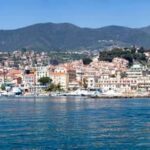The US Department of State Travel to Italy is an essential resource for American citizens planning a trip to this beautiful and historic European country. Whether you are traveling for leisure, business, or study abroad, it’s important to be aware of the latest travel advisories, safety precautions, visa and passport requirements, health and medical information, cultural etiquette and customs, as well as transportation and local tips for getting around in Italy.
Italy is a popular destination for tourists from around the world, known for its rich history, art, fashion, cuisine, and stunning landscapes. With a plethora of must-visit destinations and landmarks, such as Rome, Florence, Venice, the Amalfi Coast, and Tuscany, there is no shortage of things to see and do in Italy. However, it’s crucial for travelers to also be mindful of responsible and sustainable travel practices while exploring this captivating country.
In this article series on the US Department of State Travel to Italy, we will provide comprehensive information on all aspects of traveling to Italy with a focus on safety measures, cultural awareness, and making the most out of your visit. From understanding visa requirements to learning about local customs and finding eco-friendly travel options – we have got you covered. So grab your passport and get ready to embark on an unforgettable journey through Italy.
Travel Advisory and Safety Precautions for Italy
Italy is a popular destination for travelers from all over the world, including those from the United States. However, before embarking on your trip, it is important to be aware of any travel advisories and safety precautions issued by the US Department of State Travel to Italy. By staying informed and taking necessary precautions, you can ensure a safe and enjoyable visit to this beautiful country.
Travel Advisory
The US Department of State regularly issues travel advisories for various countries around the world, including Italy. These advisories provide important information about safety and security conditions in the country, as well as potential risks that travelers should be aware of. It is essential to review these advisories before planning your trip and to stay updated throughout your time in Italy.
Safety Precautions
While Italy is generally a safe country for tourists, it is still important to take certain safety precautions during your visit. Be mindful of your surroundings, particularly in crowded tourist areas where pickpocketing can occur. It is also advisable to avoid displaying large amounts of cash or valuable items and to secure your belongings at all times. Additionally, familiarize yourself with emergency contact information and local laws to ensure a smooth and safe experience while traveling in Italy.
Emergency Assistance
In case of emergency while in Italy, it is important to know how to seek assistance. The US Embassy and Consulates General in Italy are available to provide support and services to US citizens in need. It is recommended to keep their contact information readily accessible during your trip for quick access if needed.
Visa and Passport Requirements for Traveling to Italy
When traveling to Italy, it is important for visitors to ensure that they have the proper documentation in order to enter the country. The visa and passport requirements for traveling to Italy are essential for a smooth and hassle-free trip. As part of the visa policy of the Schengen Area, U.S. citizens do not need a visa for tourist or business trips of 90 days or less within a 180-day period.
In addition to not needing a visa, U.S. citizens must also ensure that their passports are valid for at least three months beyond their planned date of departure from the Schengen Area. It is crucial to check the expiration date on your passport before traveling to Italy as entry can be denied if it does not meet this requirement.
Travelers should also make sure that their passport has at least two blank pages for entry stamps upon arrival in Italy.
The US Department of State Travel to Italy website provides detailed information about visa and passport requirements, including updates on any changes in policies or procedures. It is recommended that travelers review this information well in advance of their departure date in order to avoid any issues with entry into Italy.
| Visa and Passport Requirements | Information |
|---|---|
| Visa Requirement | No visa required for stays of 90 days or less within a 180-day period |
| Passport Validity | Passport must be valid for at least three months beyond planned departure from the Schengen Area |
| Blank Pages | Passport must have at least two blank pages for entry stamps |
Health and Medical Information for Travelers to Italy
When traveling to Italy, it is important to be aware of the health and medical information that may impact your trip. The US Department of State Travel to Italy recommends that all travelers are up to date on routine vaccinations before visiting the country.
In addition, the Centers for Disease Control and Prevention (CDC) suggests that travelers consider getting vaccinated for Hepatitis A and B, as well as routine vaccinations such as measles/mumps/rubella (MMR), diphtheria/pertussis/tetanus (DPT), and influenza.
It is also advisable to visit a healthcare provider at least 4-6 weeks before your trip to Italy to receive any necessary vaccinations or medications. Additionally, travelers should be mindful of food and water safety while in Italy. It is recommended to drink bottled water or use water purification tablets, especially in more rural areas. Furthermore, it is important to practice good hygiene habits such as frequent handwashing to minimize the risk of traveler’s diarrhea.
In case of a medical emergency while in Italy, the country has a comprehensive healthcare system; however, it may be different from what US citizens are accustomed to. It is essential for travelers to have adequate travel health insurance and be aware of the location of nearby medical facilities. By taking these precautions and staying informed about health and medical information for travelers, visitors can enjoy a safe and healthy trip to Italy.
| Health Precautions | Italy Healthcare System |
|---|---|
| Be up-to-date on routine vaccinations | Comprehensive healthcare system |
| Consider vaccination for Hepatitis A & B | Different from US healthcare system |
| Practice food and water safety habits | Travel health insurance recommended |
Cultural Etiquette and Customs in Italy
Italy is a country with a rich cultural heritage and deep-rooted customs that are important to understand before traveling. Here are some key cultural etiquette and customs to keep in mind when visiting Italy:
– Greetings: Italians greet each other with a handshake and may add a kiss on each cheek for close friends or family members. It’s important to use formal titles (signore for men and signora for women) when addressing people you don’t know well.
– Dining Etiquette: When dining in Italy, it’s customary to wait to be seated by the host or hostess. It’s also polite to wait until everyone at the table has been served before beginning your meal. Remember to use utensils and avoid eating with your hands, unless it’s appropriate for the specific dish.
– Dress Code: Italians take pride in their appearance and tend to dress elegantly, especially when dining out or attending cultural events. Pack clothing that is stylish and appropriate for different settings, such as churches, where modest attire is required.
Aside from these key points of etiquette, it’s crucial for travelers to familiarize themselves with Italian customs and traditions in order to show respect for the local culture. By understanding these cultural nuances, visitors can make the most of their trip while avoiding unintentional cultural misunderstandings. For more detailed information about cultural etiquette in Italy, travelers can refer to resources provided by the US Department of State Travel website.
Must-Visit Destinations and Landmarks in Italy
When it comes to must-visit destinations and landmarks in Italy, the options are endless. From the ancient ruins of Rome to the picturesque canals of Venice, there is something for every type of traveler in this beautiful country.
Rome
Rome, the capital city of Italy, is a treasure trove of ancient history and architecture. Visitors can explore iconic landmarks such as the Colosseum, Roman Forum, Pantheon, and the Vatican City with its stunning St. Peter’s Basilica and Sistine Chapel. The city also offers charming piazzas, beautiful fountains, and delicious food at every corner.
Florence
Known as the birthplace of the Renaissance, Florence is a city filled with art, culture, and history. Travelers can marvel at masterpieces in world-renowned museums such as the Uffizi Gallery and Accademia Gallery (home to Michelangelo’s David), climb to the top of the Duomo for panoramic views of the city, and stroll across the famous Ponte Vecchio bridge.
Venice
Venice is a unique city built on a network of canals, making it a one-of-a-kind destination for travelers. Visitors can take a gondola ride along the Grand Canal, visit St. Mark’s Square and its magnificent basilica, explore colorful neighborhoods like Murano and Burano known for glass blowing and lace making respectively.
With so much to see and do in Italy, visitors are encouraged to plan their itinerary carefully to make the most of their trip while also being mindful of their safety and following any travel advisories from the US Department of State travel to Italy.
Transportation and Local Tips for Getting Around in Italy
When traveling to Italy, it’s important to plan for transportation within the country. Italy offers a variety of options for getting around, from trains and buses to rental cars and even ferries. Here are some essential tips for navigating your way through Italy:
1. Train Travel: Italy has an extensive and efficient rail network, making train travel a popular option for both domestic and international travelers. The primary train operator in Italy is Trenitalia, which offers high-speed trains as well as regional services. It’s important to book tickets in advance, especially during peak travel seasons, and familiarize yourself with the different ticket classes available.
2. Local Buses: In addition to trains, local buses are another convenient mode of transportation in Italy, particularly for reaching smaller towns and rural areas not accessible by train. Many cities also have their own public bus systems that provide easy access to key attractions and neighborhoods.
3. Car Rentals: Renting a car can be a great way to explore Italy at your own pace, especially if you plan on visiting more remote or off-the-beaten-path destinations. However, it’s important to note that driving in major cities like Rome or Naples can be challenging due to congestion and narrow streets.
4. Ferries: If you plan on visiting islands such as Sicily or Sardinia, ferries are an essential mode of transport. Several ferry companies operate routes between the Italian mainland and the islands, with varying schedules and amenities.
5. Local Tips: When using public transportation in Italy, it’s important to validate your ticket before boarding the train or bus to avoid fines. Additionally, consider purchasing a multi-day transportation pass if you plan on using public transit frequently during your stay.
As you navigate through Italy using various modes of transportation, always be aware of your surroundings and belongings to ensure a safe and enjoyable journey throughout this beautiful country.
Tips for Responsible and Sustainable Travel in Italy
When traveling to Italy, it’s important to consider the impact that tourism can have on the environment and local communities. As a responsible traveler, there are several things you can do to minimize your environmental footprint and support sustainable tourism practices in Italy. One of the first things you can do is to be mindful of your water usage. Italy experiences occasional droughts, so using water sparingly and avoiding long showers can help conserve this precious resource.
Another way to travel responsibly in Italy is by supporting local businesses and artisans. Instead of purchasing mass-produced souvenirs, seek out locally made products and support small businesses. This not only helps the local economy but also promotes cultural preservation and traditions. Additionally, try to eat at locally-owned restaurants and buy produce from farmers’ markets to support the community and reduce carbon emissions from importing food.
Furthermore, when visiting natural attractions or historical sites in Italy, make sure to follow all rules and regulations set forth by park authorities or historical preservation organizations. This includes staying on designated trails, not disturbing wildlife, and respecting any cultural or historical artifacts.
By doing so, you are helping protect these areas for future generations to enjoy. Overall, by being conscious of your actions and their potential impact, you can help ensure that your travels in Italy are both enjoyable and sustainable for years to come.
As with any international travel plans, it’s crucial to stay informed about guidelines provided by official sources such as the US Department of State Travel to Italy. Keeping up-to-date with travel advisories and regulations can help ensure a safe and enjoyable trip while adhering to responsible tourism practices recommended by reputable government agencies.
Conclusion and Resources for Further Information on Us Department of State Travel to Italy
In conclusion, traveling to Italy can be an enriching and memorable experience for any traveler. The US Department of State offers valuable resources and information to ensure a safe and enjoyable trip to this beautiful country. By staying informed about travel advisories, safety precautions, visa requirements, health considerations, and cultural etiquette, travelers can have a smooth and worry-free experience.
It is important for anyone planning a trip to Italy to review the latest travel advisory from the US Department of State to stay updated on any potential risks or concerns in specific regions. Additionally, being mindful of local customs and showing respect for Italian culture can go a long way in creating positive interactions with locals.
By familiarizing oneself with transportation options and must-visit landmarks in Italy, travelers can make the most of their time in this stunning destination.
For further information and assistance regarding travel to Italy, individuals can visit the official website of the US Department of State or contact the nearest embassy or consulate. With thorough preparation and a spirit of responsible and sustainable travel, visitors to Italy can have an unforgettable experience that respects both the local environment and community. Bon voyage.
Frequently Asked Questions
What Is Required for a US Citizen to Visit Italy?
US citizens visiting Italy are required to have a valid passport that doesn’t expire for at least three months after their planned departure from Italy. They do not need a visa for stays less than 90 days.
What Is the State Department Travel Advisory for Italy?
As of October 2021, the State Department has assigned a Level 3 travel advisory for Italy due to COVID-19, urging travelers to reconsider their trip. They also advise exercising increased caution regarding terrorism.
How Do I Notify the State Department of Travel?
Travelers can notify the State Department of their travel plans by enrolling in the Smart Traveler Enrollment Program (STEP). This free service allows US citizens traveling to Italy to receive important information from the Embassy and helps them in case of an emergency.

I’m a passionate traveler, writer, and Italophile. My fascination with Italy’s history, art, and culture has led me on countless adventures across the Italian landscape. Through “I Live Italy,” I share my love for this extraordinary country and aims to inspire others to explore its boundless beauty.





